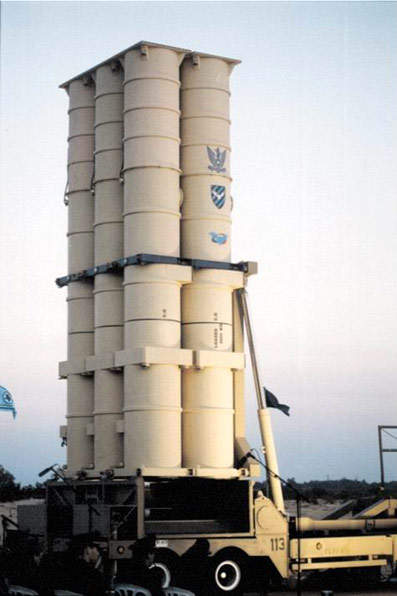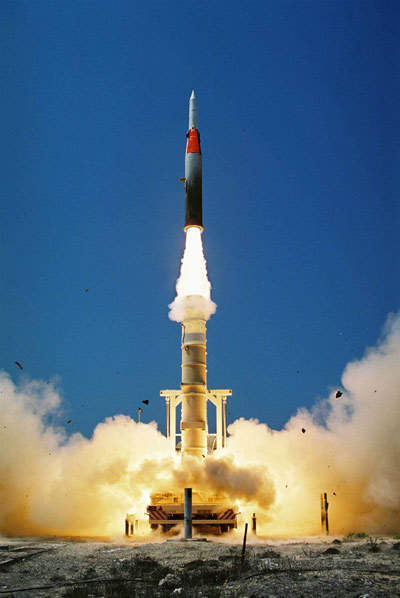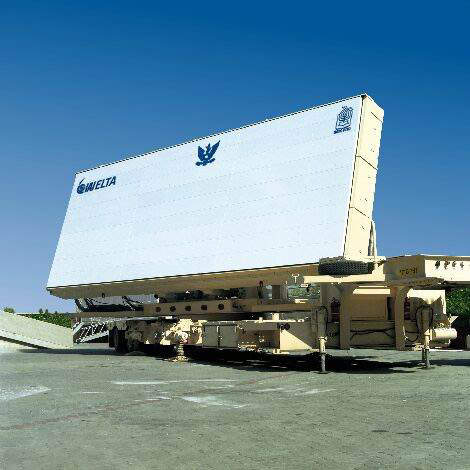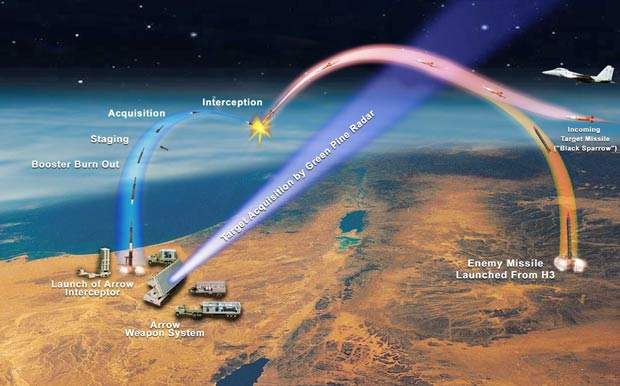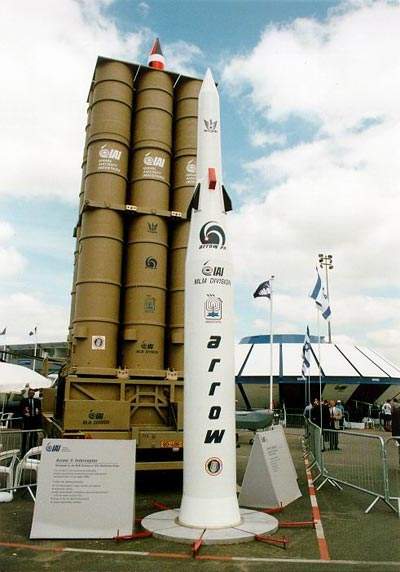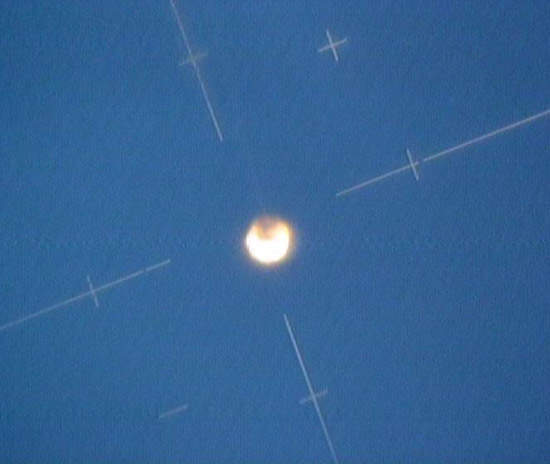The Arrow 2 anti-tactical ballistic missile (ATBM) system
The Arrow 2 theatre ballistic missile defence system has been developed by the MLM Division of Israel Aerospace Industries (formerly Israel Aircraft Industries) and is in operation with the Israeli Defence Forces.
The system, carrying the codename Homa or Fence, is deployed in two batteries, one near Tel Aviv and one to the south of Haifa. The first battery became operational in 2000, the second in 2002.
A decision on deployment of a third battery has not yet been announced, but it has been under discussion for service entry for a long time.
Arrow 2 ATBM demonstration phase
The demonstrator phase of the program began in 1988 when the US Department of Defense Strategic Defense Initiative placed a contract on the Electronics Division of Israel Aerospace Industries to build and test the Chetz-1 (Hebrew name for Arrow 1) Anti-Tactical Ballistic Missile (ATBM) system. Following the successful completion of the demonstrator tests, the system entered full-scale development and pre-production.
The weight of Arrow 1 was 2,000kg. A new missile was developed, Arrow 2, with a launch weight of 1,300kg, which was first tested in 1995.
Arrow 2 missile tests
Arrow 2 has successfully completed 14 intercept tests and there have been ten tests of the complete Arrow system. The seventh test, in July 2004, was the first test against a real rather than simulated ballistic missile, a Scud-B short-range ballistic missile.
A full Arrow battery was transported to the Point Mugu naval range in California for the test. The Scud-B was successfully intercepted and destroyed at an altitude of 40,000m. This test was part of the ongoing Arrow System Improvement Program (ASIP) being conducted jointly by Israel and the US.
In the second test at Point Mugu, in August 2004, against a target simulating a separating ballistic missile, the radar successfully acquired the target but the intercept failed in the final stage, leading to a suspension of testing.
Testing was resumed in December 2005, when an Arrow 2 block 3 missile successfully intercepted a target at an unspecified but reported record low altitude. In February 2007, the system successfully intercepted and destroyed a Rafael Black Sparrow target missile, simulating a ballistic missile, at high altitude. Both Arrow batteries took part in the test. An Arrow 2 Block 4 missile completed target-tracking test in February 2012.
Production
In February 2007, the US Missile Defense Agency agreed to extend funding for the Arrow ASIP for an additional five years, to 2013. The US Congress confirmed additional funding in November 2007. Israel also developed the Arrow 3 missile to provide top-tier air defence. Arrow 3 is a new missile capable of higher altitudes and greater ranges and be effective against intermediate range ballistic missiles.
In April 2008, the Arrow weapon system successfully detected and made a simulated intercept of Rafael’s new target missile, the Blue Sparrow, which simulates more agile ballistic missiles, such as the Iranian Shahab-3. The Blue Sparrow target was used for Arrow 3 testing, which was completed in January 2012. Arrow 3 completed its first flight in February 2013 and second flight in January 2014.
In February 2003, IAI signed an agreement with Boeing to establish the production infrastructure to manufacture components of the Arrow missile in the US.
Boeing is responsible for production of approximately 50% of the missile components in the US, including the electronics section, booster motorcase and missile canister.
Boeing also coordinates the production of Arrow missile components being manufactured by more than 150 American companies, including ATK (first and second stage rocket motor cases and first stage nozzle).
IAI is responsible for integration and final assembly of the missile in Israel. Boeing delivered its first consignment of Arrow components in November 2005.
An Arrow weapon system battery is equipped with typically four or eight launch trailers, each with six launch tubes and ready-to-fire missiles, a truck mounted Hazelnut Tree launch control centre, a truck mounted communications centre, a trailer mounted Citron Tree fire control centre and the units of a mobile Green Pine radar system.
Arrow 2 missile launch platoon
The missile launch platoon consists of the Hazelnut Tree truck-mounted Launch Control Centre (LCC), developed by IAI MLM, with four or eight missile launch trailers. The entire launch platoon is mobile and able to relocate to a new site. After firing the launchers can be reloaded in an hour.
There are microwave and radio data and voice communications links between the launch centre and the radar command and control centre. The launch system can be located up to 300km from the site selected for the radar command and control centre.
Arrow 2 ATBM
The two-stage missile is equipped with solid propellant booster and sustainer rocket motors. The missile uses an initial burn to carry out a vertical hot launch from the container and a secondary burn to sustain the missile’s trajectory towards the target at a maximum speed of Mach 9, or 2.5km/s.
Thrust vector control is used in the boost and sustainer phases of flight. At the ignition of the second stage sustainer motor, the first stage assembly separates. The first stage booster is manufactured by Israel Military Industries. Rafael manufactures the sustainer motor.
The Arrow missile is launched before the threat missile’s trajectory and intercept point are accurately known. As more trajectory data becomes available, the optimum intercept point is more precisely defined and the missile is guided towards the optimum intercept point.
The kill vehicle section of the missile, containing the warhead, fusing and the terminal seeker, is equipped with four aerodynamically controlled moving fins to give low altitude interception capability. The warhead is a high explosive directed blast fragmentation warhead developed by Rafael, which is capable of destroying a target within a 50m radius.
The dual mode missile seeker has a passive infrared seeker for the acquisition and tracking of tactical ballistic missiles and an active radar seeker used to home on air breathing targets at low altitudes. The infrared seeker is an indium antimonide focal plane array developed by Raytheon (formerly Amber Engineering).
The intercept altitudes are from a minimum of 10km up to a maximum of 50km. The maximum intercept range is approximately 90km.
Green Pine early warning fire control and missile guidance radar
The Elta Electronic Industries subsidiary of IAI Electronic Group developed the Green Pine early warning and fire control radar for the Arrow system. The radar carries the designation EL/M-2090 and includes the trailer mounted radar and antenna array, the power generator, a cooling system and a radar control centre.
Green Pine is an electronically scanned, solid state, phased array radar operating at L-band in the range 500MHz to 1,000MHz, and was developed from the Elta Music phased array radar. The radar operates in search, detection, tracking and missile guidance modes simultaneously.
The radar can detect targets at ranges up to about 500km and is able to track targets up to speeds over 3,000m/s. The radar illuminates the target and guides the Arrow missile to within 4m of the target.
Two Elta Green Pine radar systems have been delivered to India as part of that nation’s air defence system against ballistic missiles. The first was delivered in 2001.
Citron Tree fire control centre
Tadiran Electronics Limited is the prime contractor for the Citron Tree battle management / fire control centre. Citron Tree, which is trailer mounted, downloads the radar data along with data from other sources and uses powerful signal processing tools to manage the threat interceptions fully automatically, including against single and multiple threats. The system has man-in-the-loop intervention capability at every stage.
The fire control and battle management centre has computer workstations for the sky situation coordinator, intelligence officer, post mission analysis officer, resource officer and senior engagement officer as well as the commander’s station. The workstations display a large electronic map showing the area of battle. Predicted and confirmed launch sites are colour coded to show priority sites.
When a missile launch is detected, the launch site, the missile’s position and trajectory and the predicted impact point are displayed on the electronic map. The predicted impact point is displayed as an ellipse on the map. The size of the impact ellipse shrinks as the missile’s trajectory stabilises and the trajectory data becomes available. The trajectory image is colour matched to the image of its launch site. The optimum intercept point is also displayed. The centre can control up to 14 intercepts simultaneously.
Link 16, Tadil J, communications allows interoperability with Patriot fire control units. Assigned targets can be handed over to the Patriot’s N/MPQ fire control radar. Tests carried out by the US and Israel have successfully linked the Arrow and US Patriot and also the Arrow and Israeli Defence Force Patriot version.

